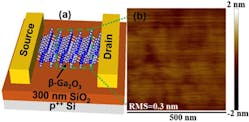Left: Schematic showing the design for an experimental transistor made of beta gallium oxide. Right: an atomic force microscope image of the semiconductor. (Purdue University image/Peide Ye)
Researchers at Purdue University have demonstrated the high-performance potential of an experimental transistor made of beta gallium oxide, which is a semiconductor. According to Purdue, this discovery could bring new ultra-efficient switches for applications such as the power grid, military ships, and aircraft.
The semiconductor is promising for next-generation “power electronics,” or devices needed to control the flow of electrical energy in circuits. Such a technology could help to reduce global energy use and greenhouse gas emissions by replacing less efficient and bulky power electronics switches now in use, the university states.
Known as a gallium oxide on insulator field effect transistor (or GOOI), the semiconductor possesses an “ultra-wide bandgap,” a trait needed for switches in high-voltage applications. Compared to other semiconductors thought to be promising for transistors, devices made from beta gallium oxide have a higher “breakdown voltage,” or the voltage at which the device fails, said Peide Ye, Purdue University's Richard J. and Mary Jo Schwartz Professor of Electrical and Computer Engineering, in the announcement.
The team also developed a new low-cost method using adhesive tape to peel off layers of the semiconductor from a single crystal, representing a far less expensive alternative to a laboratory technique called epitaxy. The market price for a 1-centimeter-by-1.5-centimeter piece of beta gallium oxide produced using epitaxy is about $6,000.
By comparison, the “Scotch tape” approach costs pennies and can be used to cut films of the beta gallium oxide material into belts or “nano-membranes,” which can then be transferred to a conventional silicon disc and manufactured into devices, Ye said.
The new technique, which was developed at Purdue’s Birck Nanotechnology Center, was found to yield “extremely smooth films, having a surface roughness of 0.3 nanometers, which is another factor that bodes well for its use in electronic devices,” according to Ye. He noted that the Purdue team achieved electrical currents 10 to 100 times greater than other research groups working with the material.










